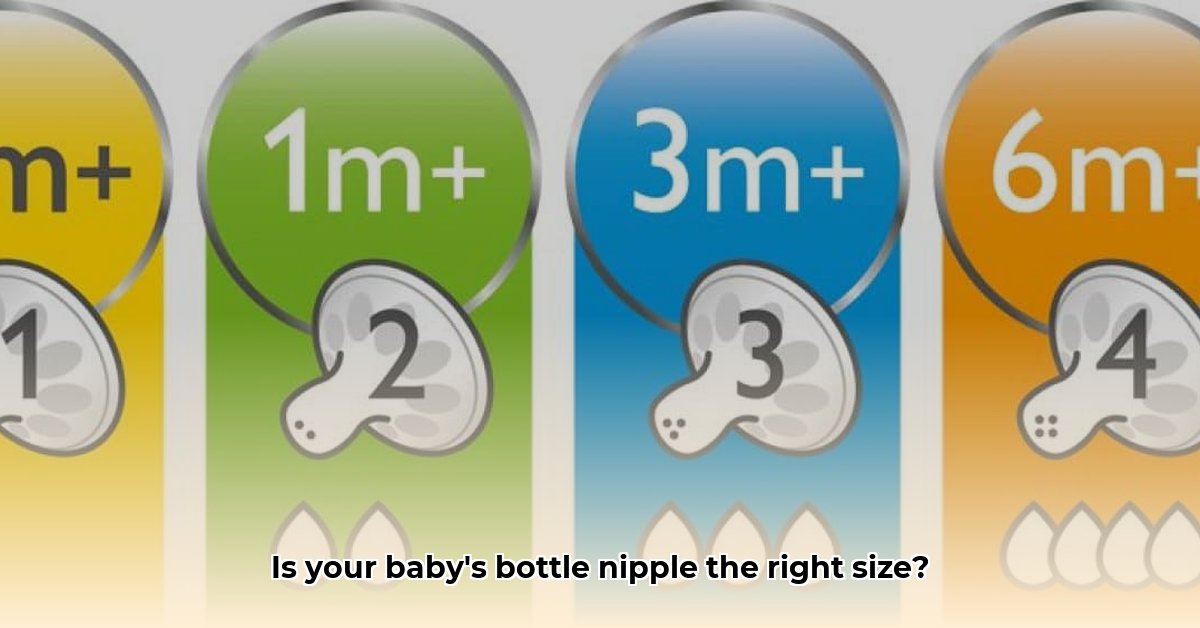Picking the right bottle nipple can feel overwhelming, but with a little guidance, you can find the perfect flow for your little one. This guide breaks down everything you need to know, from understanding flow rates to troubleshooting common issues.
Nipple Flow Rates: The Basics
Just like Goldilocks, we’re looking for a nipple flow that’s “just right”—not too fast, not too slow. The right flow ensures comfortable feeding, helps prevent tummy troubles, and keeps your baby happy and satisfied.
Quick Guide to Nipple Flow Rates
| Nipple Level/Size | Flow Rate | Typical Age Range | Description |
|---|---|---|---|
| Preemie/Level 0 | Extra Slow/Slowest | Premature babies | For babies who tire easily or have a weaker suck. |
| Newborn/Level 1/Slow | Slow | 0-3 Months | Mimics the flow of breastfeeding. |
| Level 2/Medium | Medium | 3-6 Months | For babies with a stronger suck. |
| Level 3/Fast | Fast | 6+ Months | For older babies taking larger volumes. |
| Variable/Y-Cut/Multi-Flow | Adjustable | Varies | Offers different flow rates based on positioning. Ideal for thicker liquids (e.g., formula with rice cereal). |
Important Note: Age is just a guideline. Your baby’s individual needs are most important.
Spotting the Signs: Does Your Baby Need a Nipple Change?
Your baby communicates through their behavior. Here’s how to decode their feeding cues:
Too Slow:
- Frustration: Baby fusses, pulls at the bottle, or seems angry.
- Long Feeds: Feedings consistently exceed 30 minutes.
- Fatigue: Baby dozes off mid-feed due to exhaustion, not fullness.
- Continued Hunger: Baby still seems hungry after finishing a bottle.
Too Fast:
- Overwhelmed: Baby gags, coughs, or chokes.
- Spillage: Milk dribbles or spills from baby’s mouth.
- Gulping: Baby gulps milk down rapidly.
- Digestive Upset: Baby experiences increased gas, tummy aches, or spitting up.
Choosing the Right Nipple: A Step-by-Step Guide
- Age as a Starting Point: Use your baby’s age as a general guide. Newborns typically start with slow-flow nipples.
- Observe: Watch your baby closely during feedings. Look for the signs mentioned above.
- Experiment: Try a different nipple size or shape if needed. Don’t be afraid to switch back if it doesn’t work.
- Adjust as Baby Grows: Remember that your baby’s needs will change over time. Be prepared to adjust nipple size accordingly.
Special Considerations & Troubleshooting
Preemies and Special Needs:
Premature babies and babies with specific medical conditions often require specialized nipples. Consult your pediatrician or a lactation consultant for personalized recommendations.
Manufacturer Variations:
Nipple sizes and flow rates can vary between brands. Always check the manufacturer’s guidelines for your specific bottle.
Nipple Collapse:
If the nipple collapses during feeding, ensure the bottle is properly vented or try a firmer nipple.
Excessive Gas:
Frequent burping and paced feeding can help reduce gas. Paced feeding involves holding the bottle horizontally, allowing your baby to control the flow.
Cleaning and Care:
- Wash nipples thoroughly with warm, soapy water after each use.
- Sterilize regularly according to manufacturer’s instructions.
- Replace nipples at the first sign of wear and tear (cracks, stickiness, etc.).
Frequently Asked Questions
Q: Can nipple size affect breastfeeding?
A: Some studies suggest that fast-flow nipples might make bottle feeding easier than breastfeeding, potentially leading to a preference for the bottle. If you’re combining breastfeeding and bottle feeding, discuss this with a lactation consultant. They can help you develop strategies to maintain a healthy balance.
Q: How often should I replace nipples?
A: It’s generally recommended to replace nipples every 2-3 months, or sooner if you notice any signs of damage or wear.
Additional Insights
-
Material Matters: Nipples are typically made of silicone or latex. Some babies may have a sensitivity or preference for one material over the other. Signs of a latex allergy could include skin rash, hives, or difficulty breathing. If you suspect an allergy, consult your pediatrician immediately.
-
Mimicking Breastfeeding: Some nipples are designed to mimic the shape and feel of a mother’s breast, which may be helpful for babies transitioning between breast and bottle. These nipples often have a wider base and a softer, more flexible texture.
-
Anti-Colic Features: Several bottle and nipple systems are designed to reduce colic by minimizing air intake during feeding. These systems may include vents, tubes, or specialized nipple shapes. While research on the effectiveness of anti-colic bottles is ongoing, some parents find them helpful.
-
Variable Flow Nipples: These nipples offer multiple flow rates in a single nipple, often denoted by markings like I, II, and III. The flow rate changes depending on how the baby positions the nipple in their mouth. This can be convenient for babies who are transitioning between flow stages or for feeding thicker liquids.
-
Thickened Feeds: If your pediatrician recommends thickening your baby’s formula due to reflux or other issues, you’ll likely need a Y-cut or cross-cut nipple to accommodate the thicker consistency.
Your Pediatrician: Your Trusted Resource
Remember, your pediatrician is your best source of personalized advice. They can assess your baby’s individual needs and help you choose the right nipple size and feeding strategy. Don’t hesitate to reach out with any questions or concerns.
- Affordable Employee Wellness Fair Ideas for Any Budget - December 14, 2025
- Employee Wellness Programs Strategically Benefit Employee Health And Retention - December 13, 2025
- Health and Wellbeing Companies Driving Employee Engagement and Productivity - December 13, 2025
















